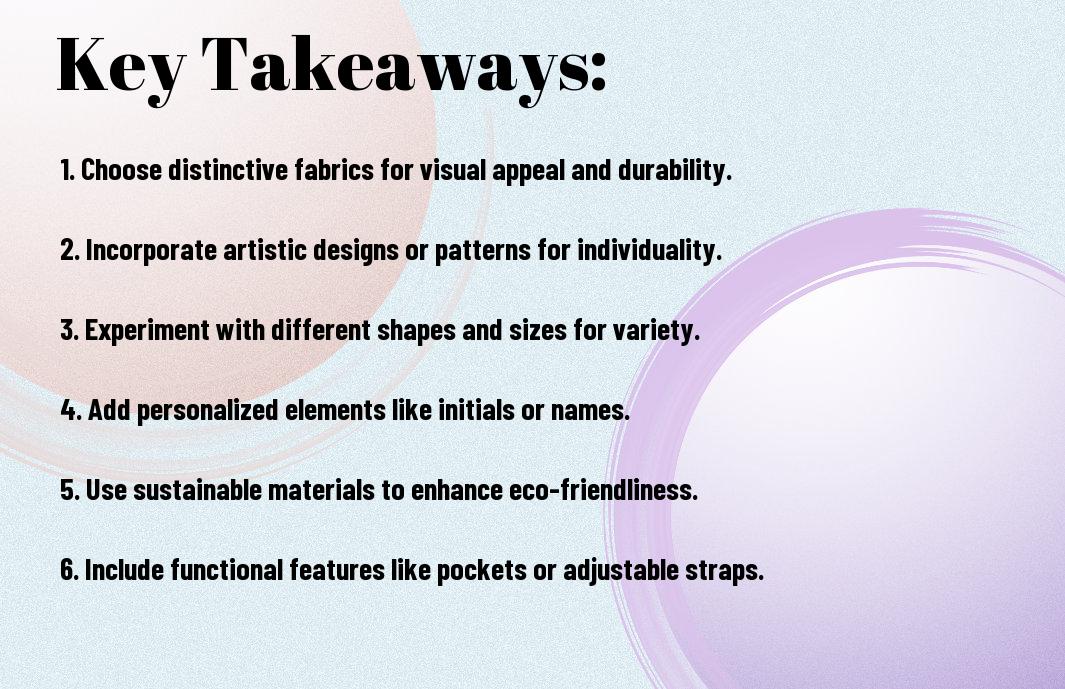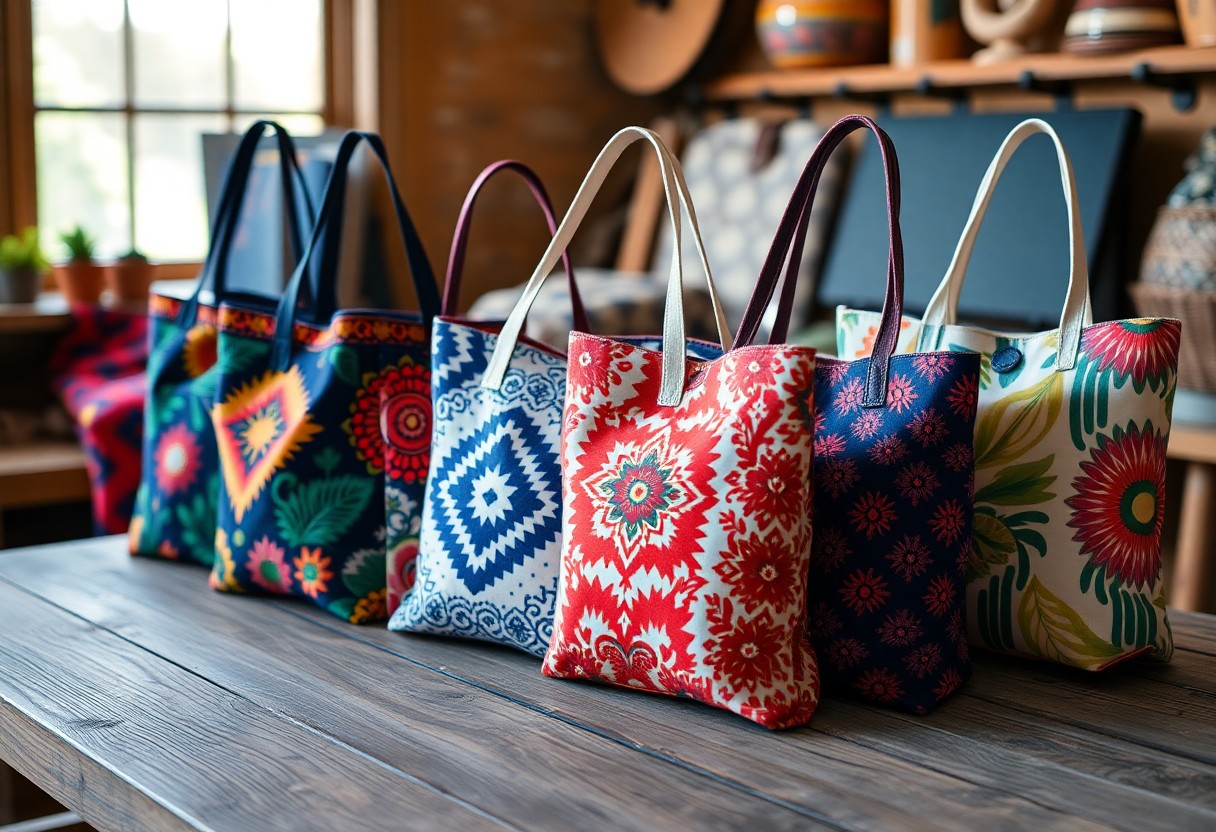You want a tote bag that stands out from the crowd. Your style is unique, and your bag should be too. You’ll learn to create a one-of-a-kind tote that reflects your personality. With a few simple steps, you’ll transform a plain bag into a work of art that’s all your own. You’ll choose the design, the fabric, and the details that make your tote truly special.
Key Takeaways:
To create unique tote bags, consider the following points:
- Start by selecting a high-quality material that is both durable and comfortable to use, such as cotton or canvas.
- Choose a unique design that reflects your personal style or brand, and consider adding custom graphics or fonts to make your tote bag stand out.
- Experiment with different colors and patterns to add an extra layer of visual interest to your tote bag, and consider adding functional features such as pockets or compartments to make it more practical.
Materials Needed
Your tote bag project begins with gathering the necessary materials. You’ll need a few basic supplies to get started, including fabric, thread, and some simple sewing tools.
Fabric Selection
Around the fabric store, you’ll find a wide range of options to choose from, consider what you want your tote to look like and what kind of material will suit its intended use.
Thread and Notions
Above all, you’ll need thread and some basic notions like buttons, zippers, or rivets to complete your tote bag. You’ll also need a sewing machine and some hand-sewing needles.
To choose the right thread and notions, you’ll want to think about the color and style of your fabric, as well as the level of durability you need. You can select thread that matches your fabric, or choose a contrasting color to add some visual interest to your tote. Consider the type of closure you want to use, such as a zipper, magnetic snap, or simple tie, and make sure you have the necessary notions on hand.

Design and Planning
Assuming you have a clear idea of what you want your tote bag to look like, it’s time to start designing. You’ll need to consider the size, shape, and style of your bag, as well as the materials and colors you’ll use.
Choosing a Theme
Around this stage, you’re thinking about the overall aesthetic of your tote bag. You’ll want to choose a theme that reflects your personality or the occasion for which you’re creating the bag.
Sketching the Design
Against a blank piece of paper, you’ll start sketching out your design ideas. You’ll want to consider the placement of any text, images, or other elements you want to include on your bag.
But as you start sketching, you’ll find that your ideas begin to take shape. You can experiment with different layouts and designs, and make any necessary adjustments before moving on to the next step. You’ll want to keep your design simple, yet striking, to ensure your tote bag stands out from the crowd.
Measuring and Cutting
Not all tote bags are created equal, and it starts with measuring and cutting your fabric. You’ll need to take your time to get it just right.
Taking Measurements
Measuring the size of your tote bag is the first step. You’ll need to decide on the length, width, and height of your bag, considering how you plan to use it and what you’ll be carrying.
Cutting Out Fabric
Cutting out your fabric is a precise process. You’ll use your measurements to cut out two main pieces, one for the front and one for the back of your tote bag, making sure to add a seam allowance.
Further, when cutting out your fabric, you’ll want to use sharp scissors or a rotary cutter to get clean edges. You’ll also need to consider the grain of the fabric, making sure to cut with it to prevent fraying or distortion. This will ensure your tote bag turns out professional and durable, able to withstand regular use.
Sewing and Assembly
Once again, you’ll need to focus on precision and patience as you sew your tote bag together. Your stitches should be even and strong, able to withstand regular use.
Piecing Together the Bag
Around this stage, you’ll start to see your bag take shape. You’ll be combining your cut fabric pieces, making sure to align them carefully and sew them together with a consistent seam allowance.
Adding Handles and Straps
By now, your bag is starting to look like a functional tote. You’ll attach your handles and straps, making sure they’re secure and evenly spaced.
This step is where you add the final touches to your bag’s functionality. You’ll want to ensure that your handles are sturdy and comfortable to carry, and that your straps are adjustable and secure. As you sew them in place, make sure to double-check your stitching to ensure it can withstand the weight and wear of your finished bag. You should test your handles and straps before completing your tote bag to make sure they are strong enough.
Embellishments and Details
For a unique tote bag, consider visiting 30+ Tote-ally Awesome Tote Bag Design Ideas for inspiration. You can add various embellishments to make your bag stand out.
Adding Pockets and Compartments
By organizing your design, you can create a functional tote. Here’s a breakdown of pocket options:
| Type | Purpose |
|---|---|
| Inner pocket | Stores small items |
| Outer pocket | Holds larger items |
Embellishing with Appliques or Patches
Pockets of creativity can be added with appliques or patches. You can use them to convey a message or add a pop of color.
Patches can be made from various materials, such as fabric, leather, or embroidery. You can place them strategically on your tote bag to create a unique design, making your bag truly one-of-a-kind as you experiment with different patterns and textures to reflect your personality.

Tips and Variations
Despite the simplicity of creating a tote bag, you can experiment with different designs. Consider the following:
- Different fabrics
- Various colors
- Unique patterns
. Knowing your options will help you create a one-of-a-kind tote bag.
Customizing the Bag
Tailoring your tote bag to your needs is easy. You can add pockets, modify the straps, or change the closure to suit your style.
Troubleshooting Common Issues
The most common issues you’ll encounter are uneven seams or loose threads. You can fix these by re-sewing the seams or tightening the threads.
Indeed, troubleshooting is an important part of the process. You’ll learn to identify and fix problems as you work on your tote bag, and with practice, you’ll become more skilled at creating unique and functional bags that reflect your personality and style, making your tote bag truly yours.
Final Words
To wrap up, you’ve got the basics down to create unique tote bags. You’ve learned to choose your fabric, design your layout, and sew it all together. Your skills will improve with each new bag you make. Now, go ahead and get creative with your designs, experiment with different materials, and make your tote bags truly one-of-a-kind. With practice, you’ll be crafting bags that reflect your personal style and make you proud to carry them.
FAQ
Q: What materials do I need to create a unique tote bag?
A: To create a unique tote bag, you will need a few basic materials, including a sturdy fabric of your choice (such as cotton, canvas, or denim), a sewing machine, thread, scissors, a measuring tape, and any additional decorative elements you want to include, like ribbons, patches, or paint. The type and quality of the materials you choose will depend on the desired look and durability of your tote bag.
Q: How do I design my tote bag to make it unique?
A: Designing a unique tote bag involves considering several factors, including the bag’s purpose, your personal style, and the recipients’ preferences if you’re making it as a gift. You can start by sketching out ideas, choosing a theme or color scheme, and deciding on any graphics, patterns, or text you want to include. Consider the overall aesthetic you’re aiming for, whether it’s minimalist, bohemian, or modern, and select materials and decorations accordingly.
Q: What are the basic steps to sew a tote bag?
A: The basic steps to sew a tote bag include cutting out your fabric to the desired size, hemming the edges to prevent fraying, sewing the sides and bottom of the bag together, creating the bag’s straps, and attaching them to the bag. Additional steps may involve adding pockets, decorative stitching, or any other custom features you’ve designed. It’s a good idea to follow a pattern or tutorial if you’re new to sewing to ensure your bag turns out professionally.
Q: How can I add personalized touches to my tote bag?
A: Adding personalized touches to your tote bag can make it truly one-of-a-kind. Consider using embroidery or appliqué to add names, initials, or special messages. You can also use fabric paint or markers to create unique designs or patterns. Incorporating personal items like photos printed on fabric, meaningful patches, or custom-made buttons can also make your tote bag more personal. Additionally, choosing a color scheme or theme that resonates with the user’s interests can make the bag feel more tailored to them.
Q: What tips should I follow to ensure my tote bag is durable and long-lasting?
A: To ensure your tote bag is durable and long-lasting, use high-quality, thick fabric that can withstand regular use. Reinforce the seams with extra stitching, especially at stress points like the straps and bottom corners. Use sturdy straps that are securely attached to the bag, and consider adding a lining to protect the inner fabric and make cleaning easier. Additionally, using a water-resistant coating or treatment can protect your bag from spills and rain, further extending its lifespan.
